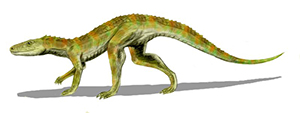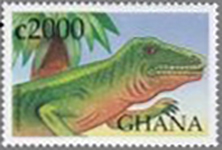Hesperosuchus agilis Colbert 1952

(Da: it.wikipedia.org)
Phylum: Chordata Haeckel, 1874
Subphylum: Vertebrata Cuvier, 1812
Classe: Sauropsida Huxley, 1864
Ordine: Sphenosuchia von Huene, 1942
Famiglia:
Genere: Hesperosuchus Colbert, 1952
Descrizione
Questo animale era di piccole dimensioni, e non doveva superare il metro e mezzo di lunghezza. Possedeva un corpo snello sorretto da due lunghe zampe posteriori, mentre le zampe anteriori erano piuttosto brevi. L’Hesperosuchus possedeva un cranio snello, basso e lungo, anche se più robusto rispetto a quello di altri animali simili come lo Sphenosuchus. Rispetto a quest'ultimo genere, l'orbita era più piccola, e la regione delle guance era più profonda. La premascella possedeva un profilo caratteristico, con le narici sporgenti in avanti. Rispetto all'europeo Saltoposuchus, il femore era più corto e le zampe anteriori più allungate. Questo animale venne descritto per la prima volta nel 1952 da Edwin Colbert, sulla base di alcuni fossili ritrovati nella formazione Chinle dell'Arizona. Altri fossili vennero poi scoperti in Nuovo Messico. L’Hesperosuchus agilis (il cui nome significa "agile coccodrillo occidentale") è considerato un tipico rappresentante degli sfenosuchi, un gruppo di arcosauri specializzati vicini all'origine dei coccodrilli, inclusi nel gruppo dei crocodilomorfi. Tra le forme più affini a questo animale, si ricordano gli europei Terrestrisuchus e Saltoposuchus, il sudamericano Pseudhesperosuchus e il sudafricano Sphenosuchus. L’Hesperosuchus era un contemporaneo del Coelophysis, un primitivo dinosauro teropode predatore. A lungo si è ritenuto che il Coelophysis fosse un animale cannibale, sulla base della presenza di presunti fossili di giovani esemplari nella regione dello stomaco di alcuni adulti. In almeno uno di questi casi, tuttavia, i fossili dei presunti giovani si sono dimostrati quelli di un Hesperosuchus o di una forma molto simile (Nesbitt et al., 2006).
Diffusione
Visse nel Triassico superiore (Carnico - Norico, circa 228 - 215 milioni di anni fa) e i suoi resti fossili sono stati ritrovati in Nordamerica.
Bibliografia
–Colbert, E. H. 1952. A pseudosuchian reptile from Arizona. Bulletin of the American Museum of Natural History 99: 561-592.
–Brinkman, D. 1981. The origin of the crocodiloid tarsi and the interrelationships of thecodontian archosaurs. Breviora 464: 1-23.
–Benton, M. J. and J. M. Clark. 1988. Archosaur phylogeny and the relationships of the Crocodylia. pp. 295–338. In M. J. Benton (ed.). The Phylogeny and Classification of the Tetrapods Vol. 1.Amphibians, Reptiles, Birds. Clarendon Press, Oxford.
–A. D. Walker, Triassic Reptiles from the Elgin Area: Ornithosuchus and the Origin of Carnosaurs, Phil. Trans. R. Soc. Lond. B 1964 248 53-134.
–Baczko, M. B. von & Ezcurra, M. D. 2013. Ornithosuchidae: a group of Triassic archosaurs with a unique ankle joint. Geological Society, London, Special Publications 379(1), 187-202.
–Lucas, S.G., 1993, The Chinle Group: revised stratigraphy and chronology of Upper Triassic nonmarine strata in the western United States: Museum of Northern Arizona, Bulletin 59, p. 27-50.
–Blakey, R. C. and R. Gubitosa. 1983, Late Triassic paleogeography and depositional history of the Chinle Formation, southern Utah and northern Arizona: in Reynolds, M.W., and Dolly, E.D., eds., Mesozoic paleogeography of west-central U.S.: Society of Economic Paleontologists and Mineralogists, Rocky Mountain Section, Denver, p. 57-76.
–HAUGHTON, S. H.1924. The fauna and stratigraphy of the Stormberg series. Ibid., vol. 12, pp. 323-497.
–Irmis, R.B., 2005, The vertebrate fauna of the Upper Triassic Chinle Formation in northern Arizona: Mesa Southwest Museum, Bulletin 9, p. 63- 88.
–Nesbitt, Sterling J.; Turner, Alan H.; Erickson, Gregory M.; Norell, Mark A. (22 December 2006). "Prey choice and cannibalistic behaviour in the theropod Coelophysis" (PDF). Proceedings of the Royal Society B. 2 (4): 611-4.

|
Data: 01/03/1999
Emissione: Dinosauri Stato: Ghana |
|---|